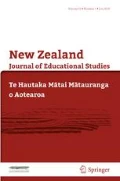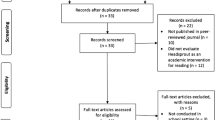Abstract
In the Western world, most 5 year old children begin their formal schooling, and do so with diverse proficiencies. A common aim is for teachers to quickly evaluate their proficiencies to identify strengths and gaps, and then begin the teaching of reading and number. This article reports two studies into the item and structural characteristics of a well used instrument administered in the first 6–8 weeks of the students’ school experience. The School Entry Assessment Kit consists of Concepts about Print (CAP) measure of early literacy, Tell Me procedures for oral language and story retelling, and Checkout game for early number knowledge and ability. The first study reviews the properties of these tests, and the second study relates the performance on the SEA with performance 1 and 5 years later. Implications for measuring progress, reviewing the tests, enhancing reporting, and reducing administration time are discussed.




Similar content being viewed by others
References
Anderson, P., Lindsey, J., Schulz, W., Monseur, C., & Meiers, M. (2001). An evaluation of the technical and methodological aspects of the school entry assessment kit. Commissioned Report to the Ministry of Education. Melbourne: ACER.
Clay, M. M. (2002). An observation survey of early literacy achievement (2nd ed.). Auckland, New Zealand: Heinemann.
Dewar, S., & Telford, M. (2003). A study of the use of school entry assessment (SEA) in schools. Research Report. Wellington, NZ: Ministry of Education, Research Division.
Education Review Office (2000). Early literacy and numeracy: The use of assessment to improve programmes for four to six year olds. Report #3. Wellington, NZ: ERO.
Gilmore, A. (2004). Towards a conceptual framework for school entry assessment. Wellington, NZ: Ministry of Education.
Goodman, Y. (1981). Test review: Concepts about print test. The Reading Teacher, 34, 445–448.
Hambleton, R. K., Swaminathan, H., & Rogers, H. J. (1991). Fundamentals of item response theory. Newbury Park, CA: Sage Publications.
Hattie, J. A. C. (2009). Visible learning: A synthesis of 800+ meta-analyses relating to student achievement. Oxford, UK: Routledge.
Hattie J. A. C. (2009, 2012). Visible learning for teachers. Maximizing impact on achievement. Oxford, UK: Routledge.
Hattie, J. A. C., Brown, G. T., & Keegan, P. (2005). A national teacher-managed, curriculum-based assessment system: Assessment tools for teaching & learning (asTTle). International Journal of Learning, 10, 770–778.
Lee, Y. Y. (2005). Mobile devices and synchronization concepts: Research report for e-asTTle. Technical Advisory Report, Visible Learning Labs, University of Auckland, New Zealand.
Leeson, H. V., Brown, G. T. L., Hattie, J. A. C., Irving, S. E., Reddish, P., MacKay, A. J., & MacCall, S. (2005). NZ students’ performance in reading (asTTle Monograph No. 3). Auckland, NZ: University of Auckland & Ministry of Education.
McNaughton, S. (1995). Patterns of emergent literacy: Processes of development and transition. Auckland, NZ: Oxford University Press.
Ministry of Education. (1997a). School entry assessment kit. Wellington, NZ: Learning Media Ltd.
Ministry of Education. (1997b). SEA guide to teachers. Wellington, NZ: Learning Media Ltd.
Philips, D. (2000). Curriculum and assessment policy in New Zealand: Ten years of reforms. Educational Review, 52(2), 143–153.
Young-Loveridge, J. (1997). From research tool to classroom assessment device: The development of Checkout/Rapua, a shopping game to assess numeracy at school entry. In F. Biddulph & K. Carr (eds.) People in Mathematics Education. Proceedings of the 20th Annual Conference of the Mathematics Education Research Group of Australasia (Vol. 2, pp. 608–614), MERGA, Rotorua, NZ.
Author information
Authors and Affiliations
Corresponding author
Rights and permissions
About this article
Cite this article
Hattie, J.A.C., Brown, G.T.L. & Earl Irving, S. An Analysis of an Assessment Tool for 5-year Old Students Entering Elementary School: The School Entry Assessment Kit. NZ J Educ Stud 50, 87–105 (2015). https://doi.org/10.1007/s40841-015-0001-4
Received:
Accepted:
Published:
Issue Date:
DOI: https://doi.org/10.1007/s40841-015-0001-4




